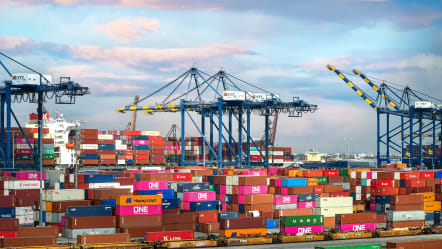Drone Technology: What Is a Drone?

“Drone” refers to an aircraft without a pilot inside. Otherwise called “unmanned aerial vehicle (UAV)", drones can be used for many tasks, from military to package delivery. The size of drones can range from fist size to small plane size.
What is a drone?
Drones are unmanned aircrafts that carry out various tasks. From very basic tasks to highly dangerous. The robot-like aircrafts can help rescue avalanche victims as well as food delivery or filming.
A drone gets remote commands from a pilot and needs software to stay in the air autonomously. Most drones have cameras for visuals and propellers for stabilizing them in the air. Different fields like photography, agriculture, transportation and search and rescue use drone technology to help them complete their work more efficiently.
Drones, which were originally developed for the military and aerospace industries, have found their way into the mainstream because of the enhanced levels of safety and efficiency they bring. These robotic unmanned aerial vehicles operate without a pilot on board and with different levels of autonomy.
The autonomy of a drone can be remotely piloted, meaning that a human controls its movements, to advanced autonomy, where it relies on a system of sensors and LiDAR detectors to calculate its movement.
Drones come in different shapes and sizes, each with its own capabilities. Short-range drones can travel up to 90 miles and are used mainly for espionage and intelligence gathering. Mid-range UAVs have a maximum distance range of 400 miles and could be used for tasks such as intelligence gathering, scientific studies, or meteorological research. Long-range drones, often called “endurance UAVs” have the capabilities of going further than 400 miles and 3000 feet high.
Remotely controlled and capable of flying at various distances and heights, drones are well-suited for some of the most difficult tasks in the world. For example, finding survivors after a hurricane, helping law enforcement/military a better overview and scientific research in harsh climates. Also, drones have become a great tool for videographers and photographers, as well as racing drone pilots and hobby pilots.
If you're interested in drones, it's worth taking the time to learn about the unmanned technology that makes them work. Pilots must take into account the various factors that make a drone suited for specific jobs. If you're looking to buy a drone, be sure to consider its ground control station (GCS), payload and data links carefully.
What is drone technology?
Drones are so fascinating because they often come equipped with rotors or fixed wings, sensors, navigation systems and gyroscopes (for stability). The provided software and hardware help the pilot successfully take off, fly and land.
UAVs
Drones themselves are often called Unmanned Aerial Vehicles, whereas the entire system allowing a drone to function is a UAS (Unmanned Aerial System). The UAV is a key component of the UAS and provides fixed wings or either a single or multi-rotary build for flight.
A UAV is an aircraft without needing a pilot on board. They are often separated into military and civilian, while civilian UAVs are mostly used for package delivery and videography. Military drones are used for intelligence gathering and espionage, as well as missile strikes on enemies.
Small and large Ground Control Stations are necessary for UAVs and UASs to operate - get one that suits your needs! The GCS is an amazing tool that can be used to control flight, payload sensors, and provide status readouts.
Payloads
Drones can carry a variety of payloads, from packages to medicine. Operators must choose the right drone to complete the job efficiently and effectively.
Data Links
Data links are vital to a drone's communication with the ground operator while in flight, providing data like remaining flight time, distance from the operator, distance from target, airspeed, and altitude. UAVs that can be controlled at 2.4 GHz for control and 5 GHz for video will provide the operator with approximately four miles of usability, while frequencies of 900 MHz for flight control and 1.3 GHz for video control can provide more than 20 miles of usability — making it essential for pilots to use the right UAS for the task they mean to achieve.
How do they fly?
Gyroscopes and vertical take-off and landing (VTOL) capabilities make controlling drones rather easy. GPS and LiDAR technology help drones navigate. Drones are becoming more and more popular because they are able to complete tasks under changing conditions.
VTOL Drones
More and more people are using drones because of their Vertical Take-off and Landing (VTOL) capabilities. They can start, hover and land in a vertical position.
GNSS for Drones
Dual Global Navigation Satellite Systems (GNSS) like GPS and GLONASS drones are the best type of drones because they can operate in both non-satellite and satellite modes, providing enhanced connectivity during operation.
GNSS is an important safety feature for drones, and can be activated through the ground station’s remote controller. This is vital information for pilots to have so they can make informed decisions about whether or not to fly their drone. Furthermore, the Return to Home feature is very useful to prevent losing the drone or crashing unnecessarily. When losing connection or when the battery is low, Return to Home is activated automatically, but can also be activated manually.
Gyroscopes in Drones
A gyroscope is essential for any drone because it helps keep the drone stable in the air and provides a smooth flying experience.
Types of drones
Different industries require different types of drones, and drone technology is constantly evolving to meet these needs. By producing these four types of drones, companies can offer a variety of options for their customers.
MOST COMMON TYPES OF DRONES
- Single-Rotor Helicopter Drones
- Multi-Rotor Drones
- Fixed-Wing Drones
- Fixed-Wing Hybrid VTOL Drones
- Single-Rotor Helicopter Drones
The single rotor helicopter is a versatile and stable UAV that can be used for a variety of purposes, including surveying land, researching storms, and mapping erosion caused by global warming.
Multi-Rotor Drones
These drones can usually spend 20-30 minutes in the air carrying a lightweight payload, such as a camera, making them perfect for capturing those special moments.
Fixed-Wing Drones
Fixed-wing drones are much more efficient than regular drones, because the wings provide lift instead of rotors. These drones are usually larger, so they have to take off and land on a runway like a plane. Fixed-Wing drones are used by the military to fire missiles, by scientists to carry large amounts of equipment and by nonprofits to deliver food to hard-to-reach places.
Fixed-Wing Hybrid VTOL Drones
Fixed-wing hybrid VTOL drones are the best of both worlds, offering the endurance of a fixed-wing design and the vertical flying capabilities of a rotor-based design. Companies are using fixed-wing hybrid VTOL drones to deliver packages faster and offer a more versatile flight experience.
What are drones used for?
Drones are playing an increasingly important role in a wide variety of industries, from wildlife conservation to medical supply delivery.
USES AND APPLICATIONS OF DRONES
- Military
- Delivery
- Emergency rescue
- Agriculture
- Outer space
- Wildlife and historical conservation
- Medicine
- Photography
Military
Drones have been used by the military for centuries to gain an advantage against enemies. Measuring 36 feet long, the MQ-9 Reaper can fly 50,000 feet in the air undetected and is equipped with a combination of missiles and intelligence gathering tools.
Delivery
Delivery drones are a quick and easy way to get your packages delivered right to your doorstep. Drones are a more efficient delivery alternative to delivery drivers, and can carry up to 55 pounds of goods right to your door. Many companies are currently developing methods to deliver their packages via drones.
Emergency rescue
Drones are an important tool in rescue situations because they can go places and do things that humans can't. Kaman, an aircraft manufacturer, has developed a pilotless helicopter called the K-MAX that can carry more than 6,000 pounds of cargo.
Agriculture
Drones have been shown to help improve the agriculture industry by conducting field surveys, seeding, tracking livestock and estimating crop yield.
Outer Space
The X-37B UAV is a highly advanced piece of technology that could help us explore space more efficiently. The Air Force has said that the primary objectives of the X-37B are to develop reusable spacecraft technologies and to conduct experiments that can be returned to Earth for examination.
Wildlife and Historical Conservation
Drones are a cheaper and more efficient alternative to human conservation efforts. Having an eye-in-the-sky allows wildlife conservationists to track roaming groups of animals, ranging from Orangutans in Borneo to Bison on the Great Plains, to get a better idea of the health of their species and ecosystems. Conservation drones also make perfect tools in the fight against poaching efforts in Asia and Africa.
By using drones to drop seed vessels filled with seeds, fertilizers and nutrients, we can help trees grow back after a fire has destroyed their home. Seed-planting drone technology is a more efficient way to reforest the 300 million acres deforested by humans.
Drones are being used to map out 3D renderings of historical sites like Chernobyl, Ephesus, and Jewish cemeteries all over Europe. Historical preservationists can use 3D imagery to find clues about culture and architecture while recreating lost sites.
Medicine
Drones are the best way to get medical supplies to people in hard-to-reach areas. Drones are proving to be a reliable and efficient way to deliver medical supplies and cargo to rural communities in Alaska.
Drones are changing lives by delivering donated organs to transplant patients in need. Delivery time for organs could thereby be cut to a fraction.
3D modelling
LiDAR drones are the best way to survey landscapes and build 3D models. In addition to making it easier to navigate various surfaces, LiDAR also allows drones to find targets in search and rescue missions, evaluate crops in agriculture, and more.
Photography
Drones have been a boon for photographers who use UAVs to take expansive aerial photos. They provide a new way to photograph some of your favorite destinations from above.
What are the challenges of drones?
Drones are providing innovative solutions to many industries' most pressing challenges. However, a lot of concern has been expressed about possible problems that arise with an excessive use of drones commercially.
Drones and Privacy
Drones often have cameras which allow operators to take photos and record videos without the subject’s consent, raising privacy concerns.
Drone airspace
Drones can help us reach places we couldn't before, making search and rescue missions more effective. The presence of drones may even preclude emergency aircraft from providing assistance in some cases, putting lives at risk.
Drone crashes
Unmanned aircraft pose a large risk to people, property, and the environment as the number of drones in use scales upward.
And Cybersecurity
By feeding false GPS coordinates to a drone, hackers can take control of it, and they can even intercept data transmitted between a drone and its remote controller. In order to protect drones and the information they store, people should take extra precautions, such as implementing anti-virus software, adopting firmware patches and using strong passwords.



















